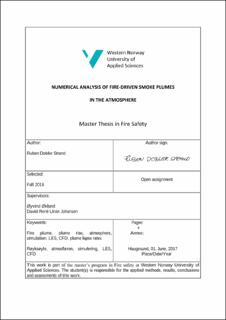| dc.description.abstract | Plumes originating from fires may serve as a risk for people and environmental safety. Depending on what fuels a fire the content of the plume will vary [1]. From simple carbonaceous soot particulates, known to cause thousands of premature deaths [2], to radioactivity and embers. They could all be a part of a rising plume. Knowledge on plume rise therefore becomes essential when impact of fire plumes shall be assessed.
Theory suggest that a rising stack plume cools adiabatically [3]. However, a fire is somewhat different from a stack plume. Fire plumes are highly buoyant and can have significant vertical momentum over a greater vertical length scale [4].If a fire plume has regions of adiabatic rise then it could serve as means for simplified calculations. However, the meteorological conditions are highly influential on a rising plume and needs to be considered. By expressing the atmospheric conditions through lapse rates of temperature, that is, the change of temperature with height. Then, such lapse rates could be compared to theoretical plume lapse rate of temperature. Together they could form a new method for assessing plume rise.
This thesis investigated fire plume lapse rates in an environment of synthetic turbulence. It was found that certain regions of plume rise cools adiabatically. It could serve as a simplified approach if the height of adiabatic cooling was known. This height refers to the height at which cooling by expansion overcomes cooling by entrainment. The adiabatic cooling appears to be the case for neutral and near neutral conditions which is consistent with theory. Further, importance of stabilities was found to decrease with increasing winds. This is caused by the effective reduction in final rise heights for increased wind velocities. Results suggest this to be related to a critical velocity. A velocity for which effects of increased winds appear with less impact on the final rise height. Plume rise calculations may become simpler during such conditions as the height may solely rely on wind speeds. However, for calm winds, stability is of major importance.
For a rising plume in calm conditions small increases in the wind velocities are seen to reduce the final rise height by roughly 50 %. Clearly, during such conditions any minor changes in atmospheric winds could significantly alter the situation.
The contribution of this study has been to partly break down the complex development of the plume lapse rates. More manageable areas concerning the development of the lapse rates have been pointed out. If these areas are well understood it is believed that the final rise height of a fire plume or other buoyant plumes could be assessed through plume lapse rates. | en_US |

